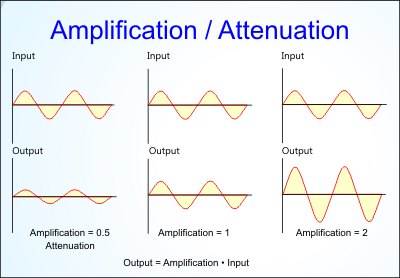EAV and bioresonance terminology
Amplification / Attenuation
Amplification refers to how much an input signal has been magnified in comparison to its original level. Attenuation means reducing the strength of the signal to less than its original level.
One goal of EAV and bioresonance is to balance the EAV reading at acupuncture nodes to the value of 50 on the scale of the EAV device. When using information from a test preparation, the transmission of the information from the ampoule directly has a signal strength of approximately 1 to 1. Frequently, this weak signal will not be strong enough to bring about the desired energetic balance at the acupuncture node and therefore of the organ or system being tested. To achieve the necessary resonance effect and an optimal result, the output signal strength level often needs to be amplified by some multiple of the original preparation’s signal strength. The output may need to be many times stronger than the original input signal to produce the desired effect.
Each case requires the amplification to be tested and adjusted individually. Therefore, you should not use bioresonance with a fixed amplification factor without first testing for the optimal amplification level. Usually arbitrary fixed amplifications do not produce the ideal resonance effect.

Examples of Amplification and Attenuation.
A bioresonance device should work with different amplifications during any given application. The facts are quite complicated, but the way amplification is used in bioresonance applications typically varies from one manufacturer to another.
Nonetheless, very high amplifications should be avoided in bioresonance – unless you are working in a Faraday cage (electromagnetically isolated environment). Otherwise, you run the risk that interference from the environment will disturb the device and create a very imbalanced effect. Amplifications of about 100 are usually sufficient. To be on the safe side, Holimed bioresonance devices monitor the output signal and send a warning tone or even turn off the device if unwanted signals are detected.
Attenuating the signal means using a value of less than 1. For example, an amplification of 0.1 means an attenuation to one tenth of the original signal level.
